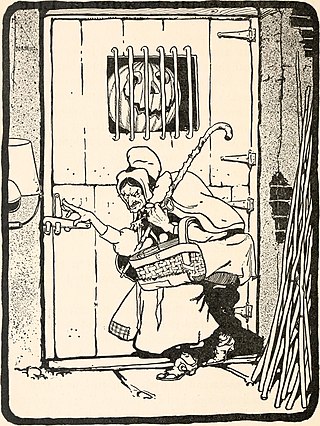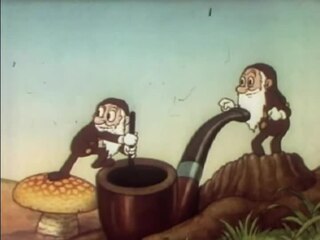External links
- The Princess and the Pauper at IMDb
- The Princess and the Pauper is available for free viewing and download at the Internet Archive
- Vimeo
| The Princess and the Pauper | |
|---|---|
Production companies | Jam Handy Organization Chevrolet |
| Distributed by | Jam Handy Organization (JHO) |
Release date |
|
Running time | 7 minutes |
| Country | United States |
| Language | English |
The Princess and the Pauper is a 1939 Technicolor cartoon sponsored film by Chevrolet. [1] It features Nicky Nome, who also appeared in the previous Chevrolet films A Coach for Cinderella and A Ride for Cinderella , as well as One Bad Knight , Nicky Rides Again and Peg-Leg Pedro . [2] The Princess and the Pauper is in the public domain and runs for approximately ten minutes.
A king offers his daughter's hand in marriage to the wealthiest suitor in the kingdom. She is wooed by the despicable wizard Ali Kazam, but falls for a pauper boy with a yo-yo. The boy is kicked out of the palace by the king's men, whereupon the diminutive magical creature Nicky Nome appears to help him, giving him a flying carpet to travel to a valley of jewels. When Ali Kazam attacks on a vulture, Nicky gradually transforms the carpet into a Chevrolet motor car.

Pete is a cartoon character created by Walt Disney and Ub Iwerks of The Walt Disney Company. Pete is traditionally depicted as the villainous arch-nemesis of Mickey Mouse, and was made notorious for his repeated attempts to kidnap Minnie Mouse. Pete is the oldest continuing Disney character, having debuted in the cartoon Alice Solves the Puzzle in 1925. He originally bore the appearance of an anthropomorphic bear, but with the advent of Mickey in 1928, he was defined as a cat.
"Cinderella", or "The Little Glass Slipper", is a folk tale with thousands of variants that are told throughout the world. The protagonist is a young girl living in forsaken circumstances that are suddenly changed to remarkable fortune, with her ascension to the throne via marriage. The story of Rhodopis, recounted by the Greek geographer Strabo sometime between 7 BCE and 23 CE, about a Greek slave girl who marries the king of Egypt, is usually considered to be the earliest known variant of the Cinderella story.

Minnie Mouse is a cartoon character created by The Walt Disney Company. As the longtime sweetheart of Mickey Mouse, she is an anthropomorphic mouse with white gloves, a red or pink bow, blue polka-dotted dress, white bloomers and low-heeled shoes occasionally with ribbons on them. The Mickey Mouse comic strip story "The Gleam" by Merrill De Maris and Floyd Gottfredson first gave her full name as Minerva Mouse, although this is seldom used.

The Prince and the Pauper is a novel by American author Mark Twain. It was first published in 1881 in Canada, before its 1882 publication in the United States. The novel represents Twain's first attempt at historical fiction. The plot concerns the ascension of nine-year-old Edward VI of England in 1547 and his interactions with look-alike Tom Canty, a London pauper who lives with his abusive, alcoholic father.

Three Wishes for Cinderella is a Czechoslovak-East German fairy-tale film from 1973.

Ozma of Oz: A Record of Her Adventures with Dorothy Gale of Kansas, Billina the Yellow Hen, the Scarecrow, the Tin Woodman, the Cowardly Lion and the Hungry Tiger; Besides Other Good People Too Numerous to Mention Faithfully Recorded Herein, published on July 30, 1907, was the official third book of L. Frank Baum's Oz series. It was the first in which Baum was clearly intending a series of Oz books.

The Scarecrow of Oz is the ninth book set in the Land of Oz written by L. Frank Baum. Published on July 16, 1915, it was Baum's personal favorite of the Oz books and tells of Cap'n Bill and Trot journeying to Oz and, with the help of the Scarecrow, overthrowing the cruel King Krewl of Jinxland. Cap'n Bill and Trot had previously appeared in two other novels by Baum, The Sea Fairies and Sky Island.

The Deadly Desert is the magical desert in Nonestica that completely surrounds the fictional Land of Oz, which cuts it off from the rest of the world.

Mombi is a fictional character in L. Frank Baum's classic children's series of Oz Books. She is the most significant antagonist in the second Oz book The Marvelous Land of Oz (1904), and is alluded to in other works. Mombi plays a very important role in the fictional history of Oz.

Henry Jamison "Jam" Handy was an American Olympic breaststroke swimmer, water polo player, and founder of the Jam Handy Organization (JHO), a producer of commercially sponsored motion pictures, slidefilms, trade shows, industrial theater and multimedia training aids. Credited as the first person to imagine distance learning, Handy made his first film in 1910 and presided over a company that produced an estimated 7,000 motion pictures and perhaps as many as 100,000 slidefilms before it was dissolved in 1983.

The Wonderful Wizard of Oz, known in Japan as Ozu no Mahōtsukai, is a Japanese anime television series adaptation based on four of the original early 20th century Oz books by L. Frank Baum. In Japan, the series aired on TV Tokyo from 1986 to 1987. It consists of 52 episodes, which explain other parts of the Oz stories, including the events that happened after Dorothy returned home.

A Ride for Cinderella is a 1937 Technicolor cartoon sponsored film, and is a sequel to A Coach for Cinderella. The storyline is simple: Cinderella meets her young prince, but has to leave him when the clock turns to midnight. Meanwhile, the head dwarf, Nicky Nome, has to stop the wicked witch, hired by the evil stepsisters, from ruining Cinderella's chance of marrying the prince.

A Coach for Cinderella is a 1936 Technicolor animated cartoon sponsored film based on the Cinderella fairy tale. Directed by Max Fleischer for Jaminson Handy, the film is an advertisement for Chevrolet automobiles.
Peg-Leg Pedro is a 1938 Technicolor cartoon sponsored film.
Down the Gasoline Trail is a 1935 cartoon sponsored film created to promote Chevrolet automobiles. It is about an animated drop of gasoline, who travels through the car, eventually entering the engine and being vapourised. It is in the public domain.

Aladdin Jr. is a one-act, eleven-scene theatre musical adapted from the 1992 Walt Disney Animation Studios film Aladdin which is an adaptation of the folk tale Aladdin. The production runs between 60 and 80 minutes and includes five female parts, six male parts, and a chorus.
Cinderella is a Disney franchise that commenced in 1950 with the theatrical release of the 1950 film Cinderella. The series' protagonist is Cinderella, who was based on the character of the same name from the Cinderella fairy tale.

The Cactus Kid is a Mickey Mouse short animated film first released on May 10, 1930, as part of the Mickey Mouse film series. It was the eighteenth Mickey Mouse short to be produced, the third of that year.
One Bad Knight was a 1938 theatrical advertisement for Chevrolet, produced by the Jam Handy Organization, featuring the gnome, Nicky Nome.